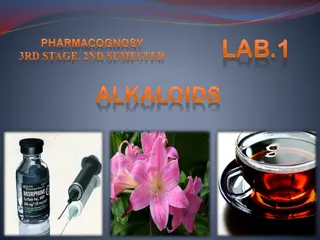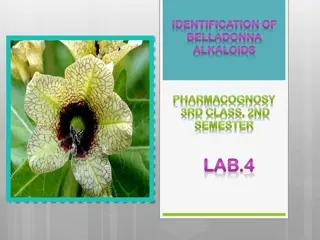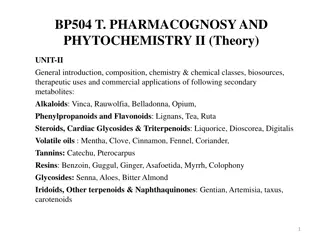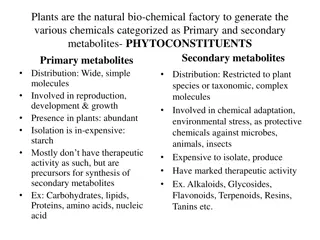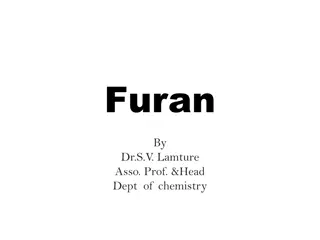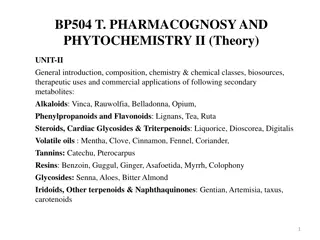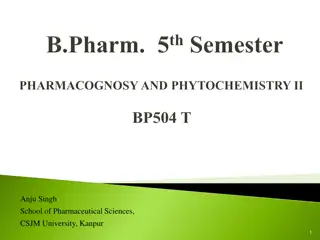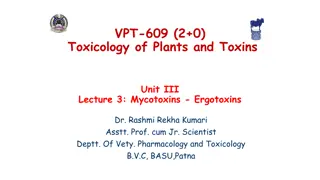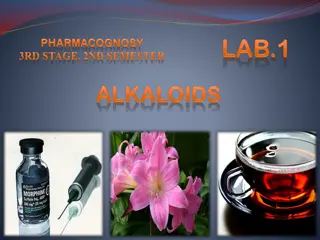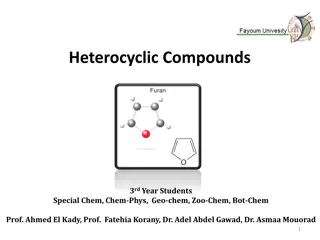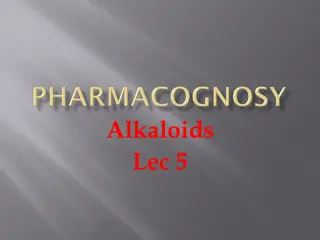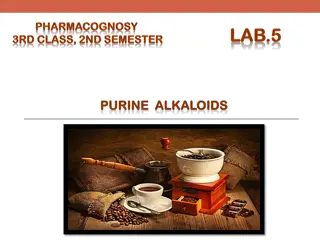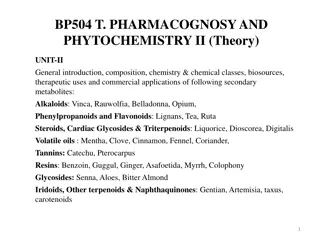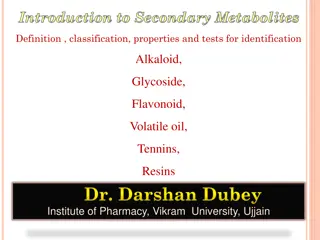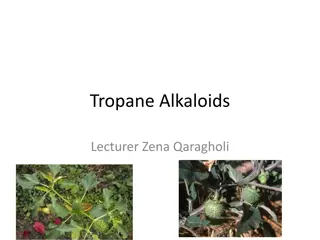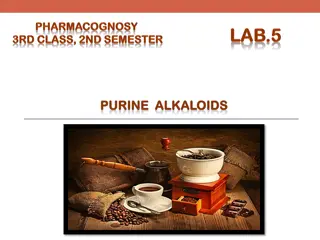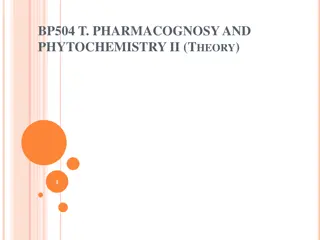Alkaloids and Heterocyclic Compounds: A Comprehensive Overview
Alkaloids are natural compounds containing nitrogen, with various pharmacological activities. Heterocyclic compounds, essential to life, include a diverse range of compounds such as alkaloids, antibiotics, and vitamins. The lecture delves into the properties, classifications, and examples of these compounds, shedding light on their significance in biological processes and drug development.
Download Presentation

Please find below an Image/Link to download the presentation.
The content on the website is provided AS IS for your information and personal use only. It may not be sold, licensed, or shared on other websites without obtaining consent from the author. Download presentation by click this link. If you encounter any issues during the download, it is possible that the publisher has removed the file from their server.
E N D
Presentation Transcript
Lucture Six Alkaloid and Hetrocyclic Compounds
Lecture six: ALKALOIDS AND HETEROCYCLIC COMPOUNDS Alkaloids :- Alkaloids are a group of naturally occurring chemical compounds that mostly contain nitrogen atom in the heterocycles and originate from amino acids. This group also includes some related compounds with neutral, and even weakly acidic properties. In addition to carbon, hydrogen and nitrogen, alkaloids may also contain oxygen, sulfur. Alkaloids are produced by a large variety of organisms including bacteria, fungi, plants, and animals, and used asPharmacological drugs due to its pharmacological activities (antimalarial, anticancer, antiasthma), Table 1:- . Table 1:- Pharmacological activities of Alkaloids . Alkaloids have a wide range of pharmacological activities Pharmacological drugs antimalarial e.g. quinine antiasthma Ephedrine anticancer e.g. homoharringtonine vasodilatory Vincamine ant hyperglycemic activities Piperine Heterocyclic Compounds:- A cyclic organic compounds are containing all carbon atoms in ring structure is referred to as a cyclic compound. If at least one atom other than carbon such as Nitrogen N, oxygen O and sulfur S are the most common heteroatoms forms a part of the ring system then it is designated as a heterocyclic compound (figure-1). Heterocyclic compounds may be of natural origin or synthetically available.
Heterocyclic compounds occur widely in nature and in a variety of non-naturally occurring compounds. A large number of heterocyclic compounds are essential to life. Various compounds such as alkaloids, antibiotics, essential amino acids, the vitamins, haemoglobin, the hormones and a large number of synthetic drugs and dyes contain heterocyclic ring systems. Knowledge of heterocyclic chemistry is useful in biosynthesis and in drug metabolism as well. Nucleic acids are important in biological processes of heredity and evolution. figure-1:- Heterocyclic compounds. Heterocyclic compounds Classification:- Heterocyclic compounds may be classified into:- The five membered heterocyclic compounds:- are consist of five cyclic compounds having one heteroatom example Furan, or consist of five cyclic compounds having more than one heteroatom example Pyrazole,Figure(2) as follow:- Figure(2):- Heterocyclic compounds Furan, Pyrazole. The Six membered heterocyclic compounds:- are consist of six cyclic compounds having one or more than one heteroatom example Pyridine, or consist of five cyclic compounds having more than one heteroatom, example Pyrimidine, Figure(3)as follow:- Figure(3) :- Heterocyclic compounds Furan, Pyrazole.
Introduction To Some Heterocyclic Compounds:- HeterocyclicIndole Ring :- The heterocyclic compound Indole(figure-4) is present in the amino acid Tryptophan. Tryptophan is a building unit of proteins. Also Indole is the base of important drugs such as INDOMETHACIN (figure-5) , which is used mostly for inhibit inflammation, Inhibit Pain in joint diseases and treat gout. figure-5:-INDOMETHACIN figure-4:- Tryptophan and Indole ring Heterocyclic Serotonin :- The other heterocyclic compound contain Indole is present in Serotonin, it s a monoamine neurotransmitter, synthesized in the central nervous system(CNS), and gastrointestinal tract (GIT) of animals including humans. Serotonin Function:- Its function in the central nervous system(CNS) It is popularly thought to be a contributor to feelings of well-being and happiness, and include the regulation of mood, appetite, and sleep. Serotonin also has some cognitive functions, including memory and learning, but in gastrointestinal tract (GIT) Serotonin is used to regulate intestinal movements. Where can you found Serotonin? Serotonin is found in mushrooms, fruits and vegetables. The highest values of 25 400 mg/kg have been found in nuts of the walnut. Serotonin concentrations of 3 30 mg/kg have been found in plantains, pineapples, banana, kiwifruit, plums, and tomatoes.
Heterocyclic DNA:- Besides the vast distribution of heterocycles in natural compounds, they are also the major components of biological molecules such as DNA. DNA is without a doubt the most important macromolecule of life. Nucleotides (adenine, thiamine, cytosine, and guanine),(figure-6)the building blocks of DNA and our genes are derivatives of pyrimidine and purine ring structures. Nucleic acid DNA is important in biological processes of heredity and evolution, so DNA when degraded in the body to Xanthine which oxidized to Uric Acid. Uric Acid crystals are deposited in joints and cause Gout in humans. figure-6:- The building blocks of DNA Heterocyclic Pyrrole :- Pyrrole is an important five membered atoms have a Nitrogen atom as a hetro atom in its structure, Pyrrole plays important role in living system, such as essential structural features of chlorophyll and Heme is Porphyrine, which consist of four Pyrrole rings held together by bridges(figure - 7). Chlorophyll and heme, the oxygen carriers in plants and animals respectively are derivatives of large porphyrine rings. Heterocyclic Pyrrole Human blood Hemoglobin Plant Chlorophyll figure 7:- Heterocyclic Pyrrole ring in Heme and Chlorophyll.
Heterocyclic amine formation in meat:- Heterocyclic amine are a group of chemical compounds, many of which can be formed during cooking. They are found in meats that are cooked to the "well done" stage, in meat surfaces that show a brown or black crust. Epidemiological studies show associations between intakes of heterocyclic amines and cancers of the colon, rectum, breast, prostate, pancreas, lung, stomach, and animal feeding experiments support a causal relationship. The U.S. Department of Health and Human Services Public Health Service labeled several heterocyclic amines as likely carcinogens, for that it must Changes in cooking techniques to reduce the level of heterocyclic amines. Sulfur Sulfur is an essential element for all life,. Three amino acids (cysteine, cystine, and methionine) and two vitamins (biotin and thiamine) are contain sulfur compounds. Many cofactors also contain sulfur including glutathione. Disulfides, S S bonds, conferm mechanical strength and insolubility of the protein keratin, found in outer skin, hair, and feathers. Sulfur is one of the core chemical elements needed for biochemical functioning and is an elemental macronutrient for all organisms. figure 8:- The octal Sulfur structure S8. Pharmaceuticals:- Sulfur (specifically octal sulfur, S8) is used in pharmaceutical skin preparations for the treatment of acne and other conditions. It acts as a keratolytic agent and also kills bacteria, fungi, scabies mites and other parasites. Precipitated sulfur and colloidal sulfur are used, in form of lotions, creams, powders, and soaps, so sulfur- containing antibiotics save many lives.
The effect and pollution of Sulfur:- Elemental sulfur is non-toxic, as are most of the soluble sulfate salts, soluble sulfate salts are poorly absorbed. When injected they are freely filtered by the kidneys and eliminated with very little toxicity in multi-gram amounts. Figure-9:-Sulfur Drugs. When sulfur burns in air, it produces sulfur dioxide. In water, this gas produces sulfurous acid and sulfites; sulfites are antioxidants that inhibit growth of aerobic bacteria and a useful food additive in small amounts. At high concentrations these acids harm the lungs, eyes or other tissues. In organisms without lungs such as insects or plants, sulfite in high concentration prevents respiration. Sulfur trioxide (made by catalysis from sulfur dioxide) and sulfuric acid are similarly highly acidic and corrosive in the presence of water. Sulfuric acid is a strong dehydrating agent that can strip available water molecules and water components from sugar and organic tissue. The burning of coal and/or petroleum by industry and power plants generates sulfur dioxide (SO2) that reacts with atmospheric water, and oxygen to produce sulfuric acid (H2SO4) and sulfurous acid (H2SO3). These acids are components of acid rain, lowering the pH of soil, and freshwater bodies, sometimes resulting in substantial damage to the environment and chemical weathering of statues and structures. Hydrogen sulfide quickly deadens the sense of smell and a victim may breathe increasing quantities without noticing the increase until severe symptoms cause death.


